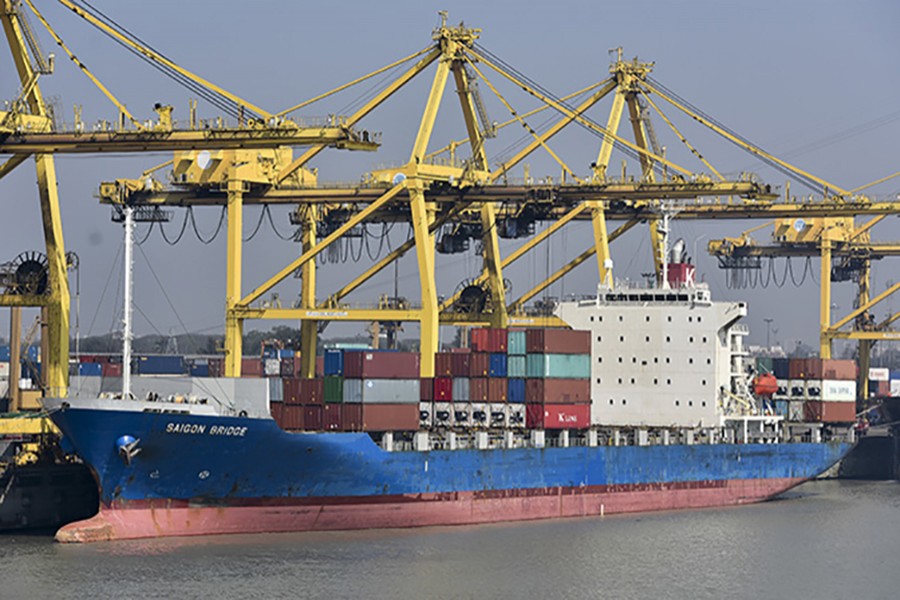The Chittagong Port Authority (CPA) is not allowing new container vessels to call at the country's main port, people familiar with the matter said on Monday.
They said many shipping firms have applied for launching new feeder vessels on the Chattogram-Colombo-Singapore route due to the rise in demands for both export and import cargoes.
The authority is not also allowing new shipping line to ply on the route.
Currently some 80 feeder vessels are operating on the route with their combined capacity of around 120,000 TEUs (20-foot equivalent units) owned by around 12 international shipping companies.
The vessels ply the Chattagram-Colombo route, around 1,600 nautical miles meant for connecting European and American nations and the far-eastern counties.
In contrast, the Chattagram-Singapore route having a distance of nearly 1,900 nautical miles connects west-coast of America.
Such restrictions or control over vessels by the authority is impacting the country's roughly US$ 80 billion external trade.
This implies that the port is not catching up with the demands.
The shipping companies now want to launch at least eight more vessels to ply on the route, people familiar with the development told the FE.
When contacted, CPA officials admitted this and said it is temporary, given the fact the entry of new vessels will worsen the port situation.
The port has now waiting time of around 20 days, including at least three days berthing delays, people familiar with the situation noted.
Such "informal" restrictions have been in place for the past six months.
This is due to limited capacity of the port.
The port's facilities have not increased keeping pace with the expanding demand mainly on the import front.
"We're not allowing new vessels as it will raise ships' stay time," said one official at its traffic department told the FE.
He said after the installation of new gantry cranes procured recently at the New Mooring Container Terminal (NCT) next month may ease the existing pressure.
"After successful installation of the gantry cranes we may enroll some vessels," the CPA official said.
The port authority had installed four gantry cranes sometime in 2007. Such ship-to-shore
gantry cranes are imposing, multi-story structures prominent at most container terminals used to load intermodal containers on and off container ships.
The cranes' productivity is usually high as it does not use ships' cranes.
However the CPA official said the port will allow new vessels on a large scale after the inauguration of a new terminal being built at Potenga area, approximately eight kilometres away from the CPA building.
The Potenga Container Terminal with three berths facilities is now under construction and it is likely to begin its operation sometime in 2019.
Top executives at the shipping companies in Bangladesh told the FE that they were now ignoring many offers in terms of carrying goods to and from Chattagram.
They said many importers from neighbouring India, Bhutan and Nepal are showing their interest to use the Bangladesh port to make their business competitive.
"We've been missing the opportunities," said Captain AS Chowdhury, country head of Sea Consortium, the second largest by number of vessels in the region.
"These opportunities are for us as business entities and for the country as well," he said.
He said many Indian companies want to use the Chattagram Port to move between the western and eastern part of India.
"Some traders from Assam have shown interest to export tea and timber by using the Chattogram Port," he said.
Mr Chowdhury said the port's handling capacity is growing on an average 10 per cent but its potential growth will stand around 20 per cent.
"To my mind, the potential growth of containerised cargoes is around 20 per cent while we consider demands being placed by many consignees and other parties," he noted.
He said the shipment of clothing is also facing troubles because of the limited capacity of the port.
On the other hand, an official working at the MCC, a business unit of Maersk Line in Bangladesh, told the FE that they also applied for a new vessel as they had adequate demand for transporting cargoes on the route.
Maersk Line, the Copenhagen-based shipping giant, has currently 19 vessels calling at the port having the largest market shares in the trade.
He said the port's facilities are not growing keeping pace with the current trade.
Port stakeholders' were critical of the CPA's move to control vessels at the port.
They said the CPA should allow the movement of vessels as trade demands as per the free market economy concept.
Mahbubul Alam, president at the Chittagong Chamber of Commerce and Industry (CCCI), told the FE that the port authority should not intervene trade.
"If it does so, this is very much unfortunate," said Mr Alam.
He, however, said the work of Bay Terminal, a proposed terminal being developed on an island on the Bay of Bengal, should be expedited to meet the growing demand.
Meanwhile, amid the limited infrastructure, the CPA handled over 2.5 million TEUs in 2017.
It now handles ships from its 12 berths designed for container vessels with no new such jetty seen/constructed in recent years.
This has resulted in vessel congestion at the port for a long.
The CPA has only four key gantry cranes at the Chittagong Container Terminal, the first dedicated container terminal in Bangladesh inaugurated in the early 90s.
Three new gantry cranes manufactured in China will be commissioned sometime in September at the NCT, port sources said.
Only 87 container loading and unloading equipment are functional at the port against the requirement of 299.
The number of cargo handling equipment is 285 against the ideal 895.


